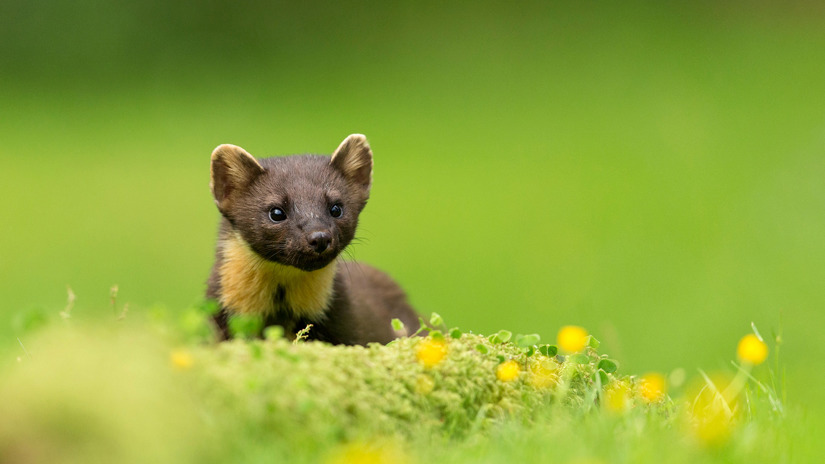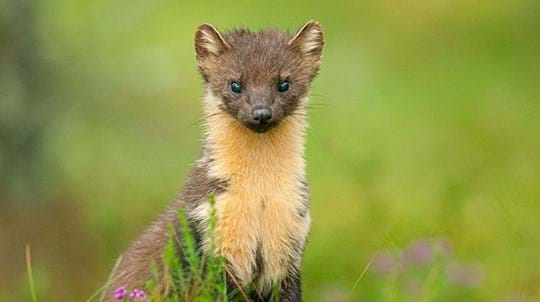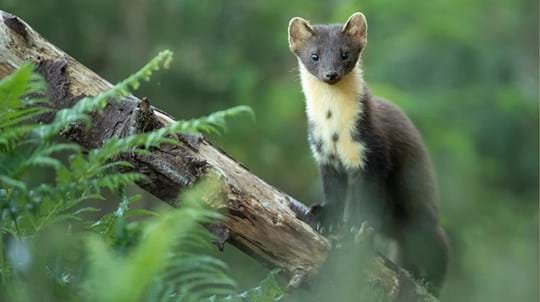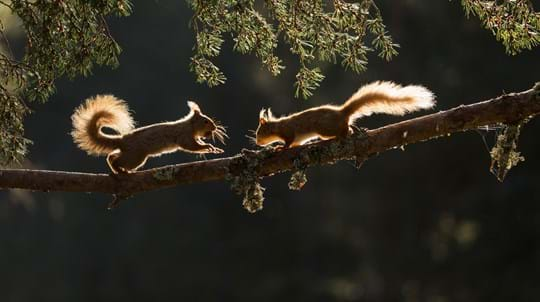
Pine marten reintroduction: how we're helping and where to find them
Once persecuted to extinction, find out how we're helping pine martens make a welcome return to the UK's woods.
Read the story
Content manager
They may look cute and cuddly, but with fierce teeth and claws and an appetite for small mammals, the elusive pine marten, Martes martes, is anything but! This iconic woodland species was once common throughout the UK. Sadly this is no longer the case, but there is hope for their future.
Pine martens come from the Mustelidae family, so are related to weasels, ferrets, polecats and otters. They look similar to these species, with round ears, quite short legs and long bodies but are larger than many of their relatives - weighing about 1-2kg and 60-70cm long from nose to tail, they are about the size of a cat. Males are around a third bigger than females.
The brown fur is thicker and lighter in winter, with a yellowish bib over the throat and chest. Pine martens are extremely agile and excellent climbers, helped by a long bushy tail for balance during treetop adventures, and large claws and thick fur on the soles of the feet for grip as they bound up tree trunks with ease. If they fall, they twist in the air like a cat to land safely on all four feet.
Although they are great climbers, pine martens tend to find most of their food on the ground, hunting at night and around dusk. Main food sources are birds, insects and small mammals like voles and rabbits, but fungi, berries and eggs make a tasty meal too - as we know only too well after our Loch Arkaig nest camera caught a sneaky pine marten stealing three eggs from the ospreys.
Interestingly, research has suggested that pine martens also prey on grey squirrels which are bigger, slower and spend more time on the ground than their red counterparts. Studies are ongoing but this could be great news for the endangered red squirrel, as well as a range of trees that are often damaged by greys stripping their bark.
Pine martens take their name from their habitat, living mostly in woodland and preferring to spend most of their time in pine trees, though they will also live in scrub, rocky areas and crags.
Found throughout Europe, in the UK they are mostly restricted to northern and central Scotland, with some populations in southern Scotland and low numbers in northern England and Wales.
Pine martens live alone, only coming together to breed in summer. They like to rest and breed above ground, so create their dens in natural tree cavities – making ancient woodland an ideal habitat - or holes created by other creatures. They have also been known to shun the hard work of building their own home and simply adopt squirrel dreys and bird nests instead!
Pine martens are very territorial and cover a large area, though this varies depending on the type and quality of habitat. Males especially have vast territories, travelling as far as five miles in one night and defending up to 25km2 - twice the area covered by females.
Unfortunately, pine martens are notoriously difficult to spot. They are so elusive that they are often studied via footprints, droppings and bits of lost fur rather than by direct sightings.
They are also shy and mostly nocturnal, although they do come out during the day in summer, and while they don’t hibernate in winter, they venture out less.
If you fancy your chances though, try visiting a wildlife hide in Scotland, or a wood known to be home to pine martens, such as Coed Hafod y Llyn in Wales, or Scotland’s Glen Quey, Glen Sherup, Geordie's Wood, Abriachan Wood, or Ledmore and Migdale.
Baby pine martens are known as kits. Born in litters of up to five, they start life blind and deaf, with a thin coat of pale hair which darkens as they mature. For the first six weeks they stay safe in their den, but then start to brave the outside world and by the age of 3-4 months have learned to kill their own prey. At six months old, they are fully grown and independent and leave the den for good to establish their own territory. They live for up to 10 years.
Although adults mate in July and August, babies are born the following spring. This is due to a process called delayed implantation, which means adults can keep their winter activities to a minimum but babies are born at the best time of year for survival.
Mating season is usually the only time that pine martens make any noise: a shrill cat-like call.

Once persecuted to extinction, find out how we're helping pine martens make a welcome return to the UK's woods.
Read the storySix thousand years ago, the pine marten was the second most common carnivore in Britain. These days it is one of the rarest. Although occasionally preyed on by foxes and eagles, the pine marten’s biggest enemy is people.
During the late 1800s, loss of habitat, the fur industry and predator control associated with game shooting caused a dramatic decline in the pine marten population. By the early 20th century, the species was close to extinction, surviving in just a few scattered pockets across the UK. In such small numbers, the species was vulnerable to disappearing completely.
Fortunately, pine martens are now protected by the Wildlife and Countryside Act 1981 and numbers are slowly increasing. Conservationists are working hard to save this special species, and we have joined the Pine Marten Recovery Project with the Vincent Wildlife Trust and other organisations to help grow pine marten populations in England and Wales. Following decades of research and survey work, 51 pine martens from healthy populations in Scotland have been carefully moved to Welsh forests, where they have established well. At least five pine martens gave birth last spring which is great news.
Bringing the pine marten back from the brink of extinction could help save our red squirrels, as well as boosting economies through ecotourism and re-establishing one of our rarest and most charismatic mammals.
If you spot a pine marten in England or Wales, please let the Pine Marten Recovery Project know.
One of the best ways to help our wildlife is to protect their habitat. You can do this by supporting our work to care for trees and woods.
Become a member of the Woodland Trust today and help save our precious woods and trees for future generations.
Find out more
Trees woods and wildlife
Woods and trees are home to more wildlife than any other landscape, providing homes for thousands of species including our most loved animals.

Blog
Hannah Vickers • 15 Apr 2019

Blog
Charlotte Varela • 09 May 2019